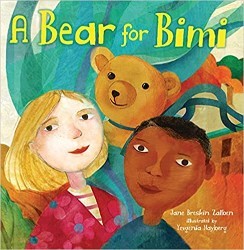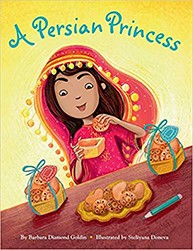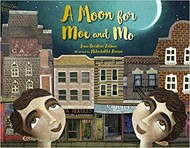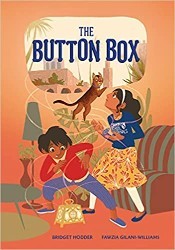The celebration of Mimouna marks the end of Passover in the Moroccan Jewish community. The holiday became popular around two hundred years ago, and includes customs not widely known outside of North Africa, Israel, and other diaspora centers. A Sweet Meeting on Mimouna Night presents the festival’s traditions embedded in a story of friendship. While a young Jewish girl, Miriam, shares much in common with her Muslim neighbor, Jasmine, she is also aware of the differences between their cultures. Emphasizing both similarities and differences between Jewish and Islamic families in their Fes (Fez) neighborhood, the book provides details about the festival, as well as an opportunity to discuss with children what makes people both unique and interconnected.
The book’s narrator adopts Miriam’s perspective. Eager to enjoy leavened bread after the eight days of Passover, Miriam asks her mother where they will find flour to cook the special delicacies marking the transition to a new week. Her mother brings her to visit their neighbors, passing a mosque on the way. Although their homes are close by, Miriam seems unfamiliar with the mosque or with the fragrant jasmine vine which is the source of her friend’s name. Young readers follow Miriam’s sense of discovery as her mother explains to her that Jasmine’s family has kept flour for their Jewish neighbors to be retrieved after their dietary restrictions end. Ofanansky subtly communicates how the bond between the two girls is also marked by separation. As they meet in the courtyard of Jasmine’s home to transfer the flour, the Jewish girl hesitates: “Miriam can run across her own courtyard easily, even at night, but here in the unfamiliar courtyard, she catches her toe on a stone and almost falls.”
Author and illustrator depict the warmth and beauty of the Mimouna celebration at which Jews and Muslims enjoy music, friendship, and food. Teplow’s pictures are delicate and understated, avoiding exoticism. The facial features of the two girls, as well as of their mothers, are strikingly similar; this seems a deliberate choice which heightens the tone of ease as the two communities interact. One image features Miriam in a gold-embroidered purple dress, and Jasmine in a green one, surrounded by foods reflecting the colors of their clothes. When the adults call out, “Next year in Jerusalem,” Jasmine asks Miriam if she and her family will really be in that city the following year. A two-page spread of Miriam and her family aboard a ship, with hopeful expressions on their faces, answers the question.
As the book’s setting moves to Israel, a poignant message emerges from its rich descriptions of a cultural legacy. After 1948, several waves of emigration from Morocco reduced the Jewish population there to its currently small number. Miriam remembers her friend, even as her family is happily settled in their new homeland. Their story is a reminder of Jewish history’s turbulent course and of the way that children adapt to larger events in their worlds. Mimouna commemorates the new season’s sweetness within the cycle of the Jewish year, and the cross-cultural exchange mirrored in the friendship between two girls.
This highly recommended book includes an afterword, “What is Mimouna?”
Emily Schneider writes about literature, feminism, and culture for Tablet, The Forward, The Horn Book, and other publications, and writes about children’s books on her blog. She has a Ph.D. in Romance Languages and Literatures.





